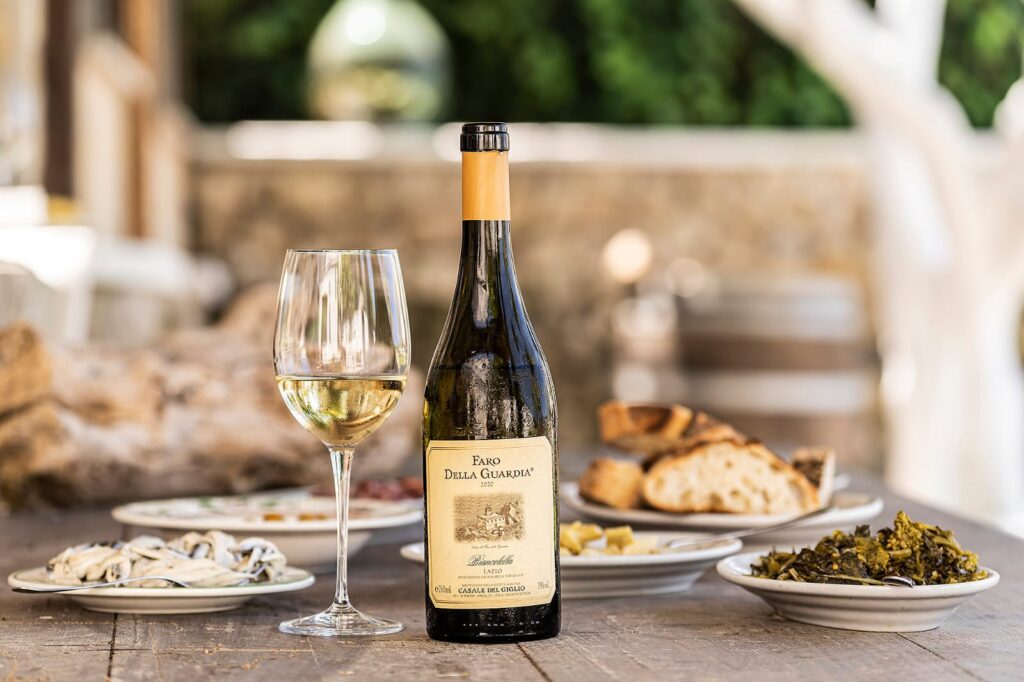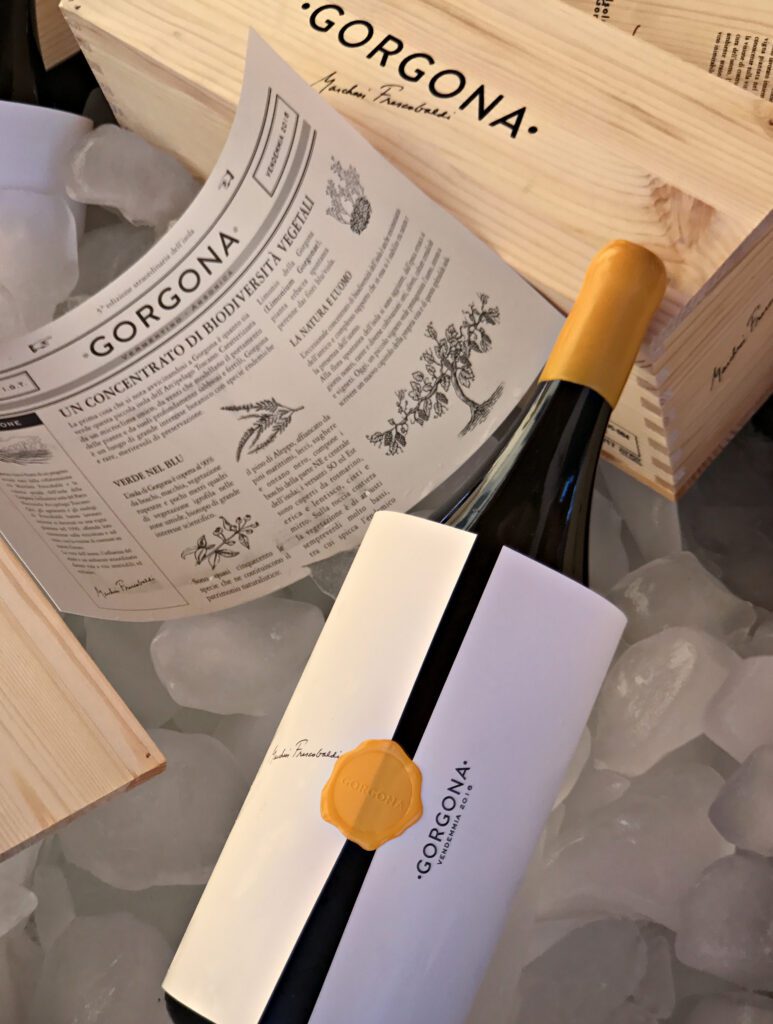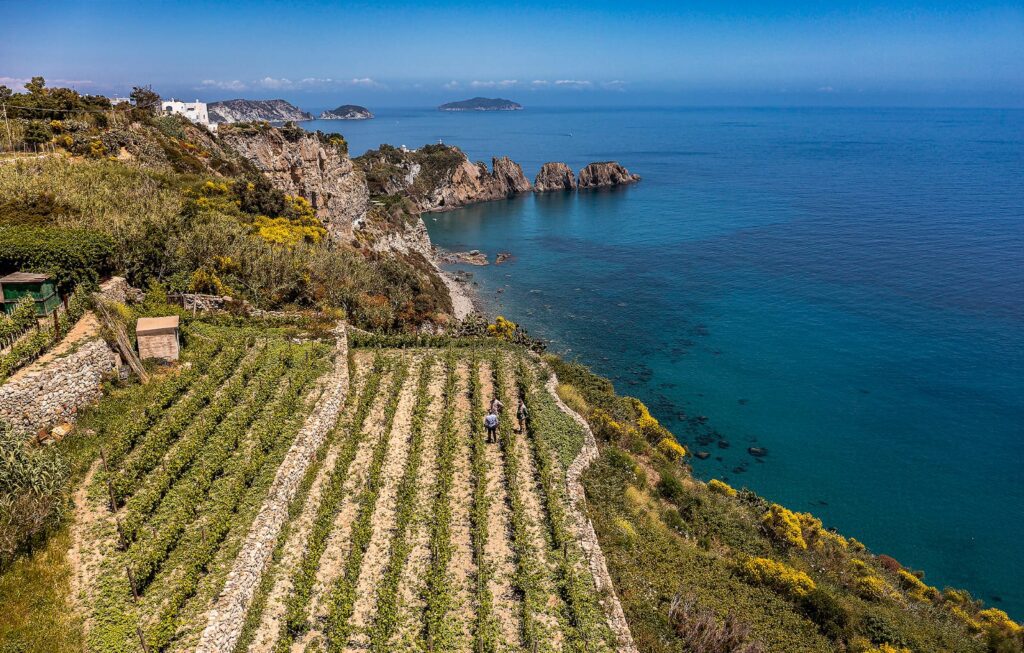FOR THOSE HEADING TO THE BEL PAESE THIS SUMMER (and who isn’t?), shake up the typical itinerary: head to the islands. Italy has over 400 isles and 13 archipelagos, and not only do these islands grant sun and sea, but they also have white wine varieties that pair perfectly with island life and, of course, island fare.
Some are familiar, like Montecristo (yes, the Count), Elba (where Napoleon lived in exile), Capri (full of international celebrities), Sardinia (full of Italian celebrities), and Stromboli, an Aeolian Island with an active volcano. These islands often have volcanic soils that enrich wines with a unique minerality, and due to the challenging terrain and remoteness, their vines need hand-harvesting. They benefit from sunny warmth and cooling sea breezes, good day-to-night temperature fluctuations, and the preservation of native grapes by virtue of their relative isolation.
Beyond Sardinia’s Vermentino and Pantelleria’s Passito di Pantelleria, there are many little-known island wines to explore. Mother Nature has graced these islands with breathtaking panoramas and rare wines that are lively, summery, and highly quaffable.






PONZA ISLAND
Biancolella
The Pontine Islands off the Roman Coast—where Romans go on holiday—hold a special place in literature. They are a reference in Homer’s Odyssey, in which Ponza was known as Aeaea and where Odysseus drank “wine as tawny mild as honey” and was bewitched by Circe. Casale Del Giglio grows its Faro Della Guardia Biancolella fruit in the volcanic limestone soils on the island. Its aromas of peach and apricot meld with citrus notes and island minerality.
MOZIA ISLAND
Grillo
Tasca d’Almerita does it again, taking on the entire island of Mozia and planting it to vine in 2007. Mozia is off the western coast of Sicily close to Marsala, Trapani, and Saline’s salt flats.
There are only two things on the island—vines and ancient ruins. Mozia’s significant archaeological finds date to Phoenician times. Alberto Tasca explained, “Imagine the Acropolis with vineyards. That’s Mozia.”
They grow the Sicilian grape Grillo to make a crisp, slightly savory wine. A crossing of native grapes, Catarratto and Moscato d’Alessandria (Zibibbo), Grillo shows broad versatility depending on where it is grown and cultivated. The water around Mozia is so shallow that ships cannot approach it, and because Tasca cannot vinify on the island, they pick at dawn and quickly transport the grapes in small boats to the mainland to press them while they are still cool.
CAPRI
Falanghina & Greco di Tufo
The most famous Italian island, Capri, is a part of the Campanian Archipelago in the Bay of Naples and boasts its own DOC (denominazione di origine controllata). Capri Bianco wine blends Greco di Tufo and Falanghina, believed to be a part of the Roman Empire’s famous Falernia. There is no time like the present to try Capri DOC wine—some landowners are removing vines because the island’s tourism makes vineyards less profitable than other tourist attractions.
SICILY
Carricante & Catarratto
Sicily is the largest island in the Mediterranean Sea, yet it also incorporates the archipelagos known as the Aeolian and Egadi Islands and Pantelleria, Lampedusa, and Mozia. Still, mainland Sicily’s Mount Etna gives white varieties Carricante and Catarratto (also known as Lucido) grapes a place to thrive before combining them to make ultra-refreshing Etna Bianco. Etna Bianco typically displays high acidity and minerality, with lemon, lime, and grapefruit notes and delicate undertones of jasmine and orange blossom.



GORGONA ISLAND
Vermentino & Ansonica
Tuscan wine producer—and 30th generation of Frescobaldi— Marchese Lamberto Frescobaldi chose Gorgona, the smallest island in the Tuscan Archipelago, to grow vines for the Gorgona Project. Once home to hermits and monks, the island became a penal colony in 1869 and is now Europe’s only working penal island. In the sun and sea air, inmates live out the remainder of their prison terms, moving around freely to work and learn new professions, which will help them assimilate into society at the end of their sentences. The Frescobaldi agronomists and oenologists work with the prisoners, planting, growing, and harvesting Vermentino and Ansonica to make the extraordinary white blend Gorgona. It shows floral and mineral aromas and oozes exotic flavors like pineapple, mango, and passionfruit, followed by citrusy tangerine.
SALINA ISLAND
Malvasia
Named for Aeolus, god of the winds, the Aeolian Islands are gorgeous slices of paradise known for Malvasia grapes. In the past, the island of Salina was primarily known for its Malvasia delle Lipari Passito, a sweet wine with a rich, aromatic profile. Tasca D’Almerita, an eighth-generation Sicilian winemaking family and Wine Enthusiast’s 2019 European Winery of the Year, produces a beautiful Malvasia Passito along with two dry Malvasia wines, Didyme and Vigna di Paola, with fruit grown on Salina and nearby Vulcano Island. Tasca d’Almerita’s estate, Capofaro, sits on a promontory overlooking the vast sea, and with its on-site lodging, it may be the ultimate enotourism. Capofaro, named after the 19th-century lighthouse that stands over the village and vineyards, is part of the prestigious Relais & Chateaux collection.
FAVIGNANA ISLAND
Zibibbo & Grillo
Favignana Island is a stunning gem accessed only by boat from Trapani and Marsala in the Egadi Islands off the west coast of Sicily. It is owned by Sicily’s Florio dynasty and is home to Firriato’s Calamoni Estate, the only wine-producing facility in the archipelago. The Firriato “Favinia” collection includes a vinification of three grapes cultivated on the island-Zibibbo, Grillo, and Catarratto—to make a white blend of La Muciara, renowned for capturing the fresh and vibrant flavors of Sicily.
